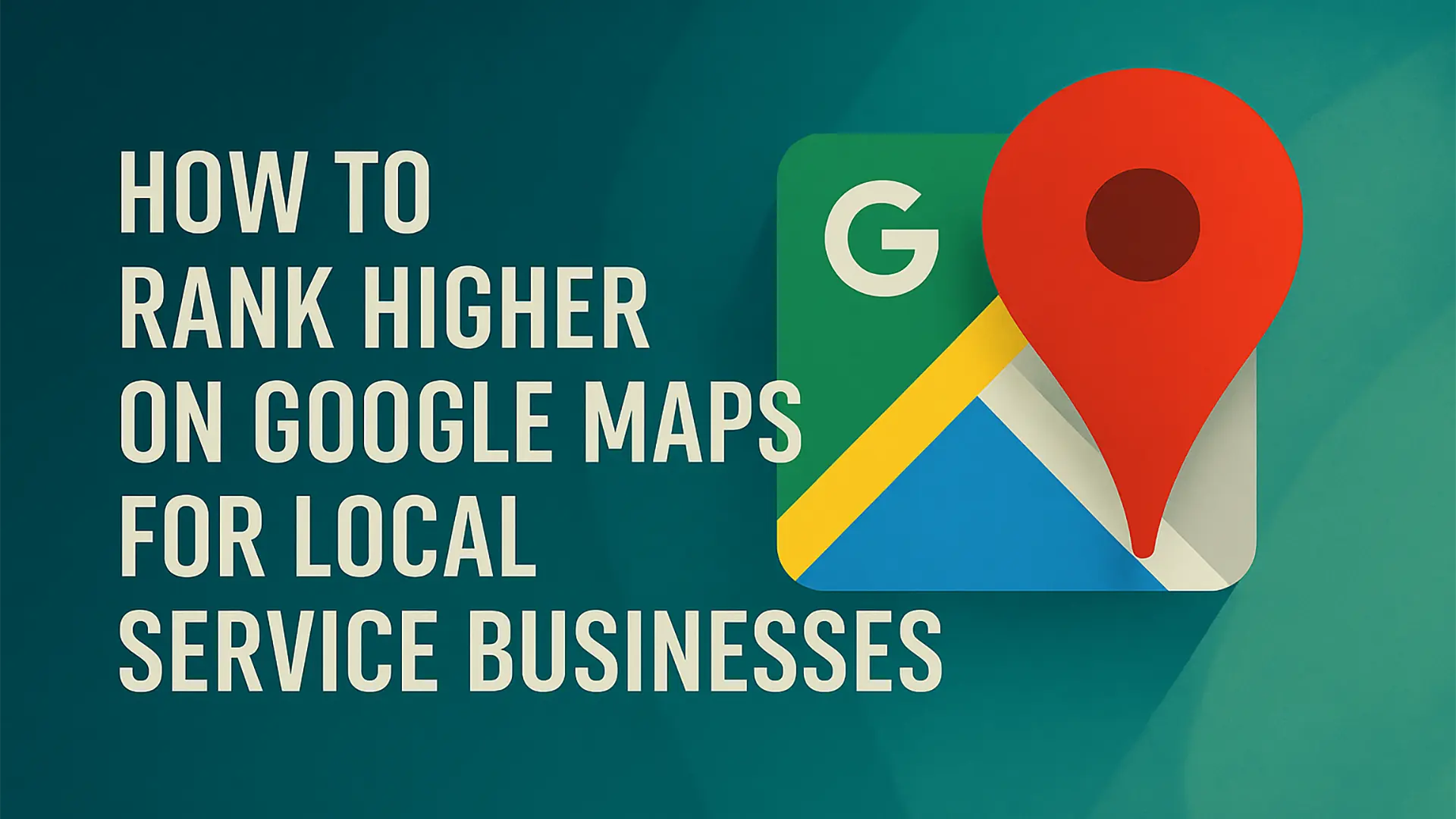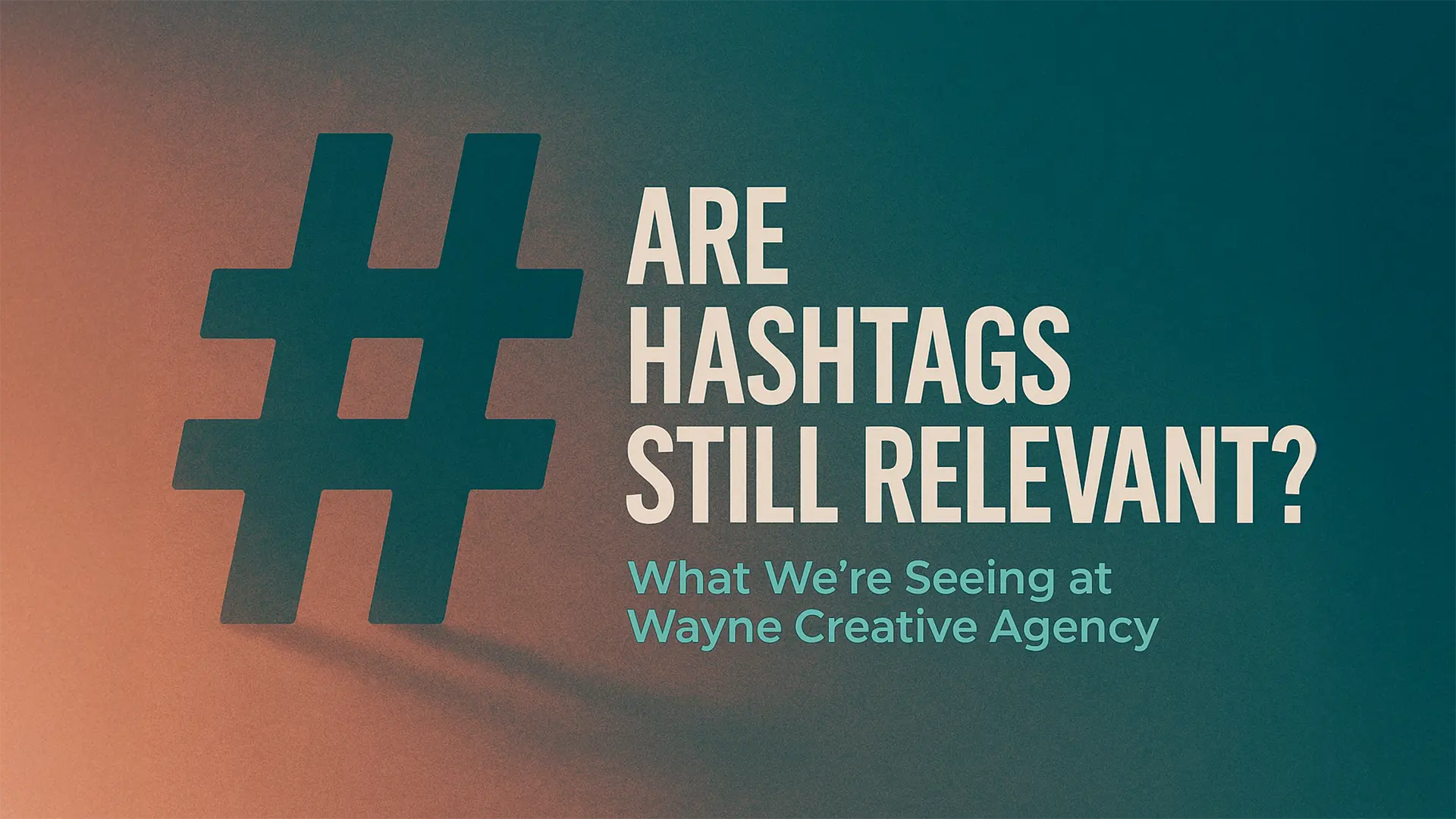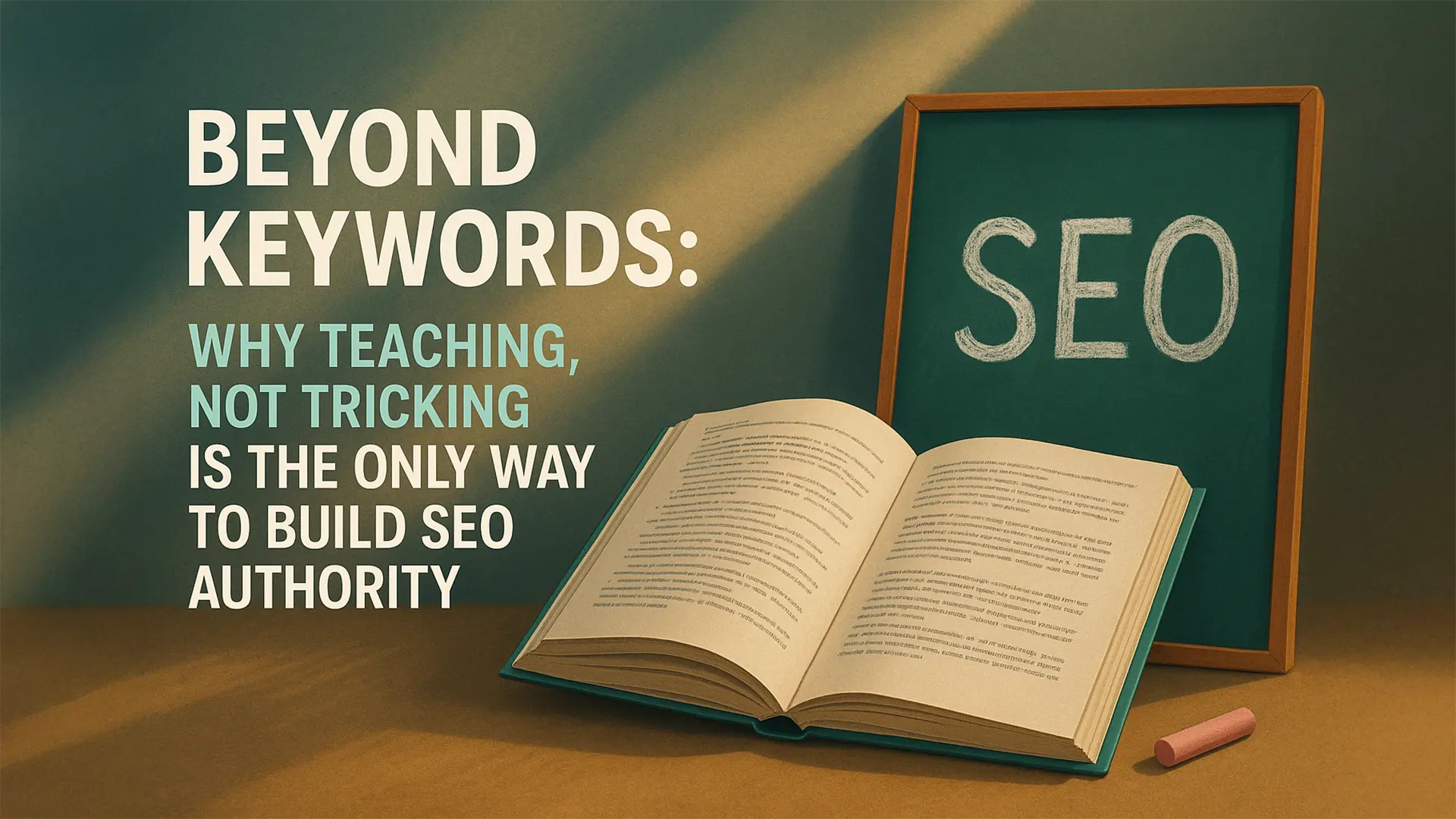Tyler Small here from Wayne Creative Agency, a website design and digital marketing shop right here in Fort Myers, FL.
Every day, I talk to local service business owners—the plumbers, the landscapers, the real estate agents, and the contractors—and they all have the same goal: they want their phone to ring. And the most powerful way to make that happen is to show up front and center on Google Maps.
Think about it. Almost half of all Google searches are for local information, and a huge number of those searches lead to a call or a visit within a day. If you’re not there, you’re missing out on a massive opportunity.
A complete profile doesn’t just help you rank; it also makes you look 2.7 times more reputable, and that builds a ton of trust with potential customers.
1. The Three Pillars of Local SEO: Relevance, Proximity, and Prominence
When a potential customer searches for a service, Google looks at three main factors to decide which businesses to show. I like to think of them as the three pillars of local SEO.
- Relevance: This is all about how well your business matches what the customer is searching for. If someone types “plumber in Fort Myers,” Google checks to see if you’re a plumbing company and if you serve the Fort Myers area.
- Proximity: This is the distance between you and the person doing the searching. Generally, the closer you are, the better. For service-area businesses like a plumber or a cleaner who travel to customers, this is a bit different. Your online reputation (Prominence) can help you show up even if you’re not right next to the searcher.
- Prominence: This is how well-known and reputable your business is. It’s your online reputation score. Google looks at the number of reviews you have, how often your business is mentioned online, and if other websites link to yours. A strong reputation tells Google you’re a trusted and established business.
For my clients who are service-area businesses, the key is to really nail the “Relevance” and “Prominence” factors to make up for not having a physical storefront right next to the searcher. We double down on those two things to ensure they get the visibility they need.
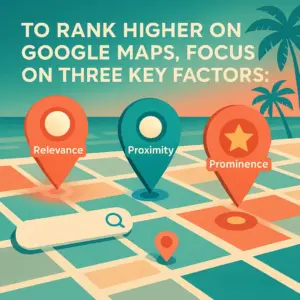
Here’s a simple table that summarizes these key factors and how we approach them:
| Ranking Factor | Definition | How Google Measures It | Actionable Strategies for Service Businesses |
| Relevance | How well a business matches the search intent and geographic context. | Matching search terms, business categories, service descriptions, and geo-identifiers. | Optimize GBP categories and service descriptions, use targeted local keywords on website. |
| Proximity | The distance between the business and the searcher’s location. | GPS coordinates, specified service areas, and inferred user location. | Accurately define service areas in GBP, embed Google Maps on website. |
| Prominence | How well-known and reputable a business is in its local area. | Number and quality of reviews, online mentions, backlinks, and overall organic search ranking. | Actively acquire and respond to reviews, build high-quality local backlinks, engage in local community. |
2. Your Google Business Profile: The Master Key to Local SEO
Your Google Business Profile is the first and most important piece of the puzzle. It’s a free tool, and it’s where you control what shows up on Google. Getting this right is absolutely critical for my clients.

The Right Way to Set Up Your Profile
For my service-area clients, the most important first step is to hide your physical address. Since you go to your customers, you don’t want people showing up at your home or office. Listing an address where you don’t serve customers is a big no-no and can get your profile suspended. You only get one profile for your entire service area, so make it count. Once it’s set up, you have to verify it. Without verification, you can’t even see the performance data, and that data is gold.
The Golden Rule: NAP Consistency
This might seem like a small detail, but it’s a huge deal. NAP stands for Name, Address, and Phone number. We make sure my clients’ business’s NAP is exactly the same everywhere online. That means on their Google Business Profile, their website, their Facebook page, their Yelp listing, and every other online directory. Inconsistent information confuses Google and makes them wonder if your business is legitimate. It also makes you look unprofessional to customers. We even make sure the website URL is consistent across all listings.
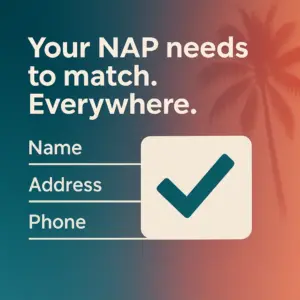
Choosing Your Business Categories (Strategically)
When we set up a new profile, we spend a lot of time on categories. This is a huge factor in Google’s “Relevance” score. The primary category is the most important one, so we make sure it’s as specific as possible. For a plumber, we’d choose “Plumber” instead of a general term like “Contractor.” Google lets you pick up to nine secondary categories, and we always use all of them! This helps you show up for a wider range of related searches.
Making Your Services and Description Shine
We treat the services section of a GBP like a menu of offerings. We list every single service and write a detailed description for each one. If we can, we’ll even add pricing information. This detailed info helps Google match your profile to specific customer searches.
The business description is your chance to tell your story. We use it to highlight what makes a client unique and make sure to naturally include a few relevant keywords. It’s a great opportunity to give a potential customer a reason to click on your profile.
Using All the Bells and Whistles: Photos, Posts, and Q&A
A basic listing is good, but a great one uses all the features Google gives you.
- Photos and Videos: We regularly upload high-quality photos and videos of our clients’ team, their services in action, and their finished projects. We’ve seen that listings with pictures get way more engagement.
- Google Posts: We use this feature like a mini-blog. We post about recent promotions, special offers, or new services. It’s a great way to keep a profile fresh and give customers a reason to click.
- Q&A: We anticipate what customers will ask and answer those questions right in the Q&A section. We also make sure to respond to any new questions quickly and professionally. It’s a fantastic way to build trust and show that you’re active and responsive.
- Attributes: We also help our clients add specific attributes to their profiles (like being a veteran or women-owned) to align with their values and connect with customers on a more personal level.
Here’s a checklist we use to make sure our clients’ profiles are always in top shape:
| GBP Element | Actionable Tip | Why it Matters |
| Business Type & Address | For service-area businesses, remove physical address; for hybrid, list both. Ensure verification. | Crucial for compliance, eligibility, and access to performance data. |
| NAP Consistency | Audit and ensure Name, Address, Phone, and Website URL are identical across all online listings. | Builds trust with search engines and customers; prevents confusion and ranking penalties. |
| Categories | Select the most accurate primary category and up to nine relevant secondary categories. | Enhances relevance, ensuring the business appears for appropriate searches. |
| Services | Clearly list and categorize all services offered, with detailed descriptions and pricing (if applicable). | Helps Google understand offerings and matches listings to relevant customer queries. |
| Description | Craft a concise, keyword-rich, and customer-focused description highlighting unique selling points. | Serves as an “elevator pitch” to attract attention and convey brand identity. |
| Photos/Videos | Upload high-quality, regularly updated images and videos of services, team, and premises. | Increases visual appeal, customer engagement, and drives actions like direction requests. |
| Google Posts | Consistently share updates, promotions, events, and new offerings. | Boosts real-time engagement and increases visibility in search results. |
| Q&A | Proactively answer common questions and respond promptly to new customer queries. | Builds trust and addresses customer doubts, influencing purchasing decisions. |
| Attributes | Add relevant identity attributes (e.g., Black-owned, women-owned, LGBTQ+ friendly). | Showcases business values and helps customers find businesses aligned with their preferences. |
3. The Power of Customer Reviews: My Secret Weapon for Prominence
Reviews are a huge factor for Google, and they’re even more important for a potential customer trying to decide between two businesses. A good reputation helps with your “Prominence” score and directly leads to more business.
How We Get More Reviews
It sounds simple, but the best way to get more reviews is to just ask for them. We always advise our clients to ask every single satisfied customer. The best time to ask is right after they’ve told you how happy they are with your service. We also make the process as easy as possible by providing a custom, short link to your Google Business Profile that you can text or email to them. We never, ever offer an incentive for a review, because Google’s rules are very strict about this, and it’s not worth risking a penalty.
Our Approach to Responding to Every Review
Whether a review is positive or negative, we tell our clients it’s a must to respond to every single one. It shows customers that you value their feedback and that you’re paying attention. For positive reviews, a simple “Thank you so much!” is great.
For negative reviews, we’ve learned that a professional and empathetic response is key. We’ll help our clients apologize for the experience and address the concerns publicly, and then offer to solve the issue offline. This shows everyone reading the reviews that you’re committed to making things right. This whole process not only helps you build trust but also boosts your prominence.
The Impact of Reviews on Your Business
Positive reviews have a direct impact on your Google Business Profile visibility. Google loves to see that you’re getting good feedback. On our clients’ websites, we also use something called “Review and Rating Schema,” which is a bit of code that lets your star rating appear right in the search results. It helps your business stand out and gets you more clicks.
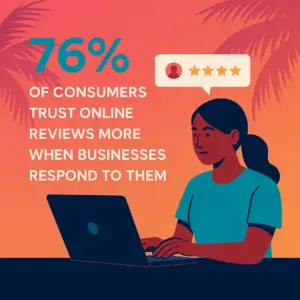
4. Your Website: The Engine for Local SEO
While your GBP is the most important piece of the puzzle, a well-optimized website is essential. It’s an extension of your business listing and it gives Google and customers more information about you.
Finding and Using Local Keywords
We spend time figuring out which keywords your customers are using. Most of them are in a “service + location” format, like “plumber in Fort Myers.” We use tools like Google Autocomplete or the “People Also Ask” section to find new keywords, and we also peek at what your competitors are ranking for. We make sure to use these keywords naturally on your website to communicate directly with your local customers and signal to Google exactly where and what you do.
Organizing Your Website for Success
We design our clients’ websites to be easy to use for both people and search engines.
- The homepage is optimized for your main service area. We prominently display your NAP information on the homepage and in the footer. We also showcase customer testimonials right on the front page to build trust immediately.
- We create a separate page for every single service you offer, with detailed descriptions.
- For clients who serve multiple towns, we create dedicated “local landing pages” for each one. This allows them to rank for organic searches in those areas even without a physical location there. This is a powerful way for service-area businesses to expand their reach.
Implementing Schema Markup (Don’t Worry, It’s Just Code!)
This is a technical step, but it’s worth it. Schema markup is a bit of code we add to our clients’ websites that helps Google understand their content better. It’s what allows things like star ratings to show up in search results.
Here are the types of schema we use:
| Schema Type | Explanation/Purpose | Key Properties/Attributes | Benefit for Local SEO |
| LocalBusiness | Essential for displaying core business information to search engines. | Business name, Address, Phone number (NAP), Opening hours. | Enhances visibility and accuracy of business details in local search results. |
| Organization | Represents the broader entity, useful for larger businesses or brand consistency. | Name, Logo, Contact information, Location. | Improves brand visibility and ensures consistency across search platforms. |
| Service | Helps web crawlers understand the specific services offered by the business. | Service type, Provider, Area served, Description. | Leads to better indexing and relevance in search results, indirectly boosting SEO. |
| Review and Rating | Highlights customer reviews and ratings directly in search results. | Rating, ReviewCount, Author, DatePublished. | Increases visibility and helps the business stand out with social proof. |
| FAQ and Q&A | Addresses common customer questions directly within search results. | Question, Answer. | Improves visibility, provides direct answers, and enhances voice search results. |
You can use a tool like Google’s Structured Data Markup Helper to create this code. After we implement it, we always use Google’s testing tool to make sure it’s working correctly.
Embedding a Google Map on Your Website
We always make sure to embed a Google Map on a client’s “Contact Us” page. It’s a simple thing to do, but it provides a visual confirmation of their service area. It also helps Google connect their website to their Google Business Profile and reinforces their geographic relevance.
5. Building Authority: My Backlink and Citation Strategy
Beyond the website, we work on building our clients’ authority online. This is all about getting other trustworthy websites to mention them.
The Critical Role of NAP Consistency in Online Directories
Just like with your GBP, your NAP information has to be perfectly consistent across all the online directories you’re listed in. These “citations” (any mention of your business online) are a key local ranking factor. We start with the big ones like Google, Bing Places, and Yelp, and then move on to smaller local directories and social media profiles. Consistent citations tell Google that your business is legitimate and trustworthy.
How We Get High-Quality Local Backlinks
For local businesses, a link from a local source is often more valuable than a link from a big national website. It tells Google that you’re a real part of your community.
Here are some of the places we look for links for our clients:
- Local Directories: We get listings on local Chambers of Commerce and other local business directories.
- Local News Sites: We’ve built relationships with local reporters and pitched stories about our clients’ businesses.
- Neighborhood Blogs: We reach out to bloggers in the area to see if a client can write a guest post or be interviewed.
- Community Sites: We’ve gotten links from local job boards and non-profit organization websites.
Getting Involved in Your Community
This is a strategy that helps our clients offline and online. We look for opportunities to get involved locally, which often leads to backlinks.
- Sponsorships: Sponsoring a local sports team or a community event often results in a link from their website.
- Partnerships: We’ve partnered with other local businesses to give them a testimonial on their site (with a link back to my client’s business) and in return, they’ve done the same.
- Charity Work: When a business volunteers or partners with a local charity, it often results in links from their websites or mentions in local news.
This table shows some of the best places to get local links:
| Source Type | Typical Authority Level (DA) | Typical Requirements/Effort | Link Value/Impact |
| Chamber of Commerce | High (60-80 DA) | Membership fee | Very Strong |
| Local News Sites | Medium-High (40-70 DA) | Newsworthy content, reporter relationships | Strong |
| City Government Pages | Very High (70-90 DA) | Business license, civic engagement | Excellent |
| Neighborhood Blogs | Low-Medium (20-40 DA) | Guest post, interview, relevant content | Moderate |
| Community Event Sponsorships | Varies (often Medium-High) | Sponsorship fee, participation | Strong (often from event/org websites) |
| Local Partnerships (e.g., testimonials) | Varies (often Medium) | Reciprocity, genuine collaboration | Moderate to Strong |
6. Keeping an Eye on Your Success: Tracking and Analyzing
Local SEO isn’t a one-and-done project. It’s an ongoing process. We regularly check to see what’s working and what’s not, and then we adjust our strategy.
Using Google Business Profile Insights
This is my go-to tool for seeing how a client’s profile is performing. Since their profile is verified, we can see a ton of data:
- Searches: We can see the exact search terms people are using to find them.
- Views: This shows us how many people have seen their profile on Google Search and Maps.
- Actions: We can see how many people have called them, asked for directions, or visited their website directly from their profile.
This data is gold. It tells us which keywords are working and which strategies are leading to real customer actions.
Using Google Search Console and Analytics
We also use Google Search Console (GSC) and Google Analytics (GA) to get a bigger picture of a client’s website performance.
- Google Search Console: GSC tells us about the website’s performance. We can see which pages are getting traffic, if there are any technical issues, and how the website looks to Google.
- Google Analytics: GA gives us a deeper look at what visitors do once they get to the website. We can see where they came from, which pages they visited, and how long they stayed.
It’s important to remember that changes take time to show up. So, we’re always patient and don’t make too many changes at once.
7. My Final Thoughts on Winning at Local SEO
Getting a high ranking on Google Maps isn’t just about a single trick; it’s about a consistent, dedicated effort across many areas. It all starts with a perfectly optimized Google Business Profile. From there, it’s about making sure your NAP information is consistent everywhere, actively getting and responding to reviews, building a great local website, and then creating authority by getting links and mentions from other local sources.
It’s a long-term game, but the payoff is huge. A strong local presence means more qualified leads, a better reputation, and ultimately, more growth for your business. By following this guide, you can start building a strong online foundation and become the go-to business in your community.
Frequently Asked Questions (FAQ)
No, absolutely not. As a service-area business, you should hide your physical address on your profile. Your customers don’t visit your location—you go to them. Listing your home address can lead to privacy concerns and can even get your profile suspended by Google. Instead, you should specify the cities, counties, or zip codes you serve.
That’s a great question, and it’s a very common one. The truth is, local SEO is a marathon, not a sprint. You might see some small improvements in a few weeks, especially from optimizing your Google Business Profile. However, for bigger changes and a noticeable increase in your ranking, it can take anywhere from three to six months. The key is to be consistent and patient.
If you can only do one thing, I would say it’s to fully optimize your Google Business Profile. Make sure your business categories are correct, your services are listed in detail, and you’ve uploaded high-quality photos. This gives you the biggest, fastest boost in your “Relevance” score and provides a solid foundation for all your other efforts.
No, you can’t be penalized for simply asking for reviews. It’s actually a best practice! What you can be penalized for is offering a reward or incentive in exchange for a review (e.g., “Leave us a 5-star review and get 10% off your next service”). Google’s rules are very clear about this. So, just ask for the review, and don’t offer anything in return.
Your website is extremely important. Your Google Business Profile and your website work together. Your website is where you can provide detailed information, use more local keywords, and build authority with backlinks. Google looks at your website’s strength and relevance to help decide how to rank your GBP. Think of your GBP as the front door to your business, and your website as the detailed, trusted store behind it.
